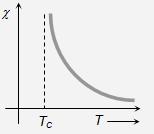Curie’s Law
The magnetic susceptibility of paramagnetic substances is inversely to its absolute temperature i.e. 

where C = Curie constant, T = absolute temperature
On increasing temperature, the magnetic susceptibility of paramagnetic materials decreases and vice versa.
The magnetic susceptibility of ferromagnetic substances does not change according to Curie’s law.
(i) Curie temperature (Tc) : The temperature above which a ferromagnetic material behaves like a paramagnetic material is defined as Curie temperature (Tc).
or
The minimum temperature at which a ferromagnetic substance is converted into paramagnetic substance is defined as Curie temperature.
For various ferromagnetic materials its values are different, e.g. for Ni, TC,iN = 358o C
for Fe, Tc,Fe = 770o C
for CO, Tc,co = 1120o C
At this temperature the ferromagnetism of the substances suddenly vanishes.
(ii) Curie-weiss law: At temperatures above Curie temperature the magnetic susceptibility of ferromagnetic materials is inversely proportional to (T – Tc) i.e. x ∝1/T-Tc ∝

x =C/T-Tc Here Tc = Curie temperature
x-T curve is shown (for Curie-Weiss Law)
